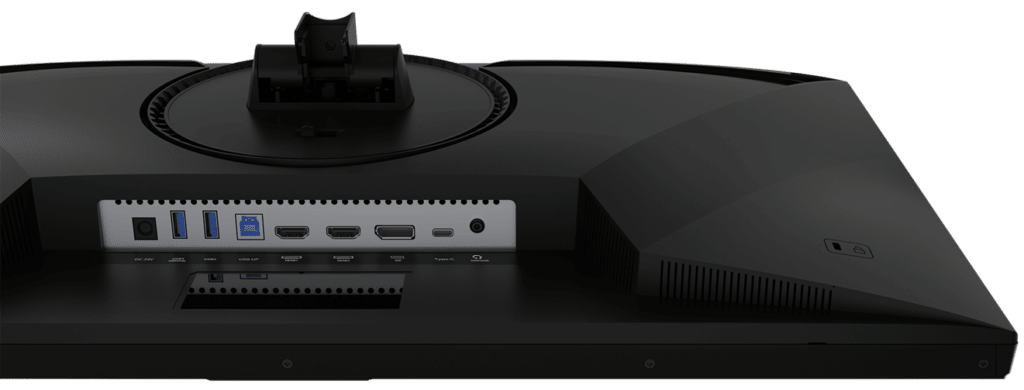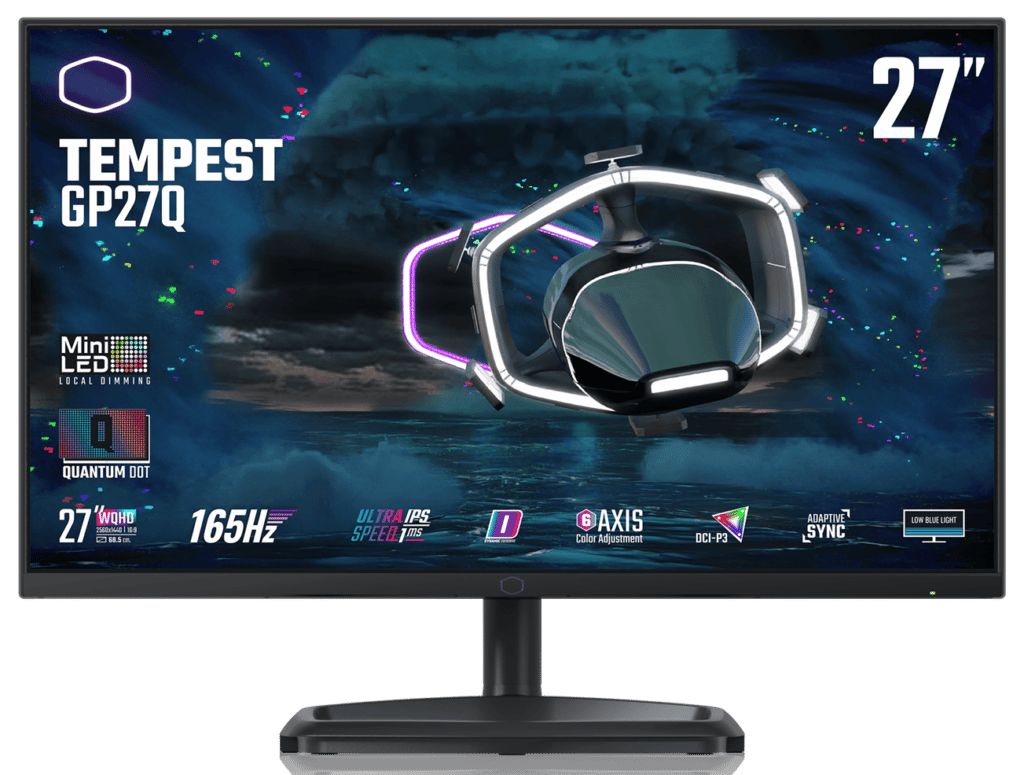The Cooler Master Tempest GP27Q is one of the few 1440p gaming monitors that have mini-LED technology for fantastic HDR performance. It is also the cheapest in this close-nit category, so it should sell like hotcakes. Let’s see how the Cooler Master Tempest GP27Q performs to know if it should be your next upgrade.
Cooler Master Tempest GP27Q Specifications
- Screen Size: 27 Inches
- Resolution: 2560 x 1440 QHD
- Aspect Ratio: 16:9
- Panel Technology: Vertical Alignment (VA)
- Refresh Rate: 165 Hz
- Response Time: 1ms MPRT
- Contrast Ratio: 1000:1
- Brightness: 600 cd/m² (1200 cd/m² Peak)
- Built-in Speakers: Yes (2 x 3 Watts)
- Stand: Height – Yes
- Stand: Tilt – Yes
- Stand: Swivel – Yes
- Stand: Pivot– Yes
- VESA Compatibility: Yes (100 x 100)
- Connectivity: DisplayPort 1.4 x 1, HDMI 2.0 x 2, USB-C PD90W x 1, USB 3.2 x 3, 3.5mm Jack x 1
Design and Features
The Cooler Master Tempest GP27Q sports a distinct aesthetic that is well-balanced between discreet and gaudy-gamer-centric. It has a matte black finish, but it has bright RGB lights at the back for users who want a themed setup. This model also has a bezel-free design but still has inner borders, as expected.
It’s not gigantically proportioned, even if the base is bigger than the usual ones we’ve seen from recent releases. It feels solid, so it is durable, but some may feel that it won’t be portable enough for gaming sessions out of the house. Note that even if it can still offset some of your bigger peripherals if disk space is very limited.
Build quality is great thanks to the brand’s expertise in creating high-quality premium products for the PC and gaming markets. The plastics used are thick and sturdy, and there were no cosmetic defects on any parts. The included stand is firm and stable, so the screen won’t sag or shake while you’re in the heat of battle.
The Cooler Master Tempest GP27Q has an OSD joystick at the back near the bottom edge of the chassis. It’s easy to reach even if you don’t see it, so it’s almost impossible to strain yourself while adjusting something from the OSD. Other monitors even include remotes, but that’s more like a creature comfort rather than a utilitarian addition.
The stand included in the package offers tilt, swivel, pivot, and height adjustments for your convenience. It is easy to get a comfortable viewing angle, so your neck doesn’t hurt after hours of gaming. You can also use VESA mounts, but that only becomes necessary if you have multiple screens or limited desk space. 
This monitor also has a pair of speakers, but we think a high-end monitor like this deserves a better pair. The built-ins have 3 watts of power each, but they are incapable of deep bass and crisp details. For better immersion, a monitor like this will work best with a good pair of gaming headsets.
Display and Performance
The Cooler Master Tempest GP27Q sports a 27-inch IPS panel with a 2560 x 1440 resolution, a 165Hz refresh rate, and a 1ms response time. The backlight has a 600 cd/m2 output and a 1200 cd/m2 peak, while the contrast ratio is listed at 1000:1. This model is capable of HDR 1000 performance which you usually will only find on higher-tiered monitors with a 4K resolution.
1440p is preferred for 27-inch monitors since it’s not too sharp or its pixel density isn’t too tightly packed. It is great for office work and basic tasks like reading and browsing, but games and movies are still more detailed. It’s the current sweet spot in the monitor business, especially since there are a lot of 1440p-capable cards that can maximize its refresh rate.
The Cooler Master Tempest GP27Q covers more than 100% sRGB and 98% DCI-P3 for stunning color in games and movies. However, due to that rich color volume, it has a naturally high deltaE average of 3.96. Users who want a better-balanced image can opt to use its sRGB mode which has a dE average of 1.06.
Calibrating the monitor reduced its dE average to a very impressive 0.64, which puts it next to prosumer variants. The downside is that you will need a colorimeter to achieve this since it’s nearly impossible to get that level of improvement if you are only winging it. However, we think gamers won’t mind the extra saturation, while those who need a more accurate setting can rely on the sRGB mode.
The Cooler Master Tempest GP27Q’s FALD backlight reached 641 cd/m2 at 100% and a 1301 cd/m2 peak when it is HDR mode is active. Its contrast ratio reached 1261:1 at 25% brightness, but its local dimming expanded that to exponential proportions. The monitor is indeed capable of true HDR performance, and we think that’s a steal at the $750 price point.
Panel uniformity for the test sample did not have massive issues like backlight leaks or bleeding on its edges and quadrants. There was some haloing in some instances when the transitions crossed the 576-zone backlight dead areas, but it is too minor to consider it a deal-breaker. Only OLEDs or mini-LEDs with more than a thousand zones are better in this regard.
The monitor’s IPS panel is fast and responsive since there is barely any blurring if you are running close to the 165Hz limit. We recommend using the Advanced mode of its overdrive since it cleans up the screen without adding massive overshoot. The monitor works great for competitive games, just like any high-end E-Sports model out there.
The Cooler Master Tempest GP27Q is compatible with both G-Sync and FreeSync, so you can enjoy VRR as needed. However, this model has the same symptom as the GP27U, wherein you can’t use VRR and HDR at the same time. Input lag sits at 4ms at 165Hz, so it is fast and responsive enough for competitive play.
Thoughts on the Cooler Master Tempest GP27Q
The Cooler Master Tempest GP27Q is a fantastic gaming monitor with impressive specifications and a gorgeous panel. Its screen’s output is impressive when it comes to color richness and HDR performance, even if it’s not factory-tuned for perfection. We love that it has a 90-Watt USB-C port since that makes it truly flexible for those who use USB-C laptops for anything other than gaming.
It is not perfect, but the Cooler Master Tempest GP27Q has a glaring flaw in the incompatibility between Adaptive Sync and its HDR mode. Cooler Master mentioned that a firmware solution is in the works, but we highly advise against getting the monitor and the GP27U until this gets resolved. However, it will instantly turn into a must-have once that gets solved.
Pros:
- Great Price
- Superb Color and HDR Performance
- Excellent Build Quality
- 90-Watt USB-C
Cons:
- HDR and VRR Incompatible
- Dismal Default Color Accuracy
- Limited Availability




Leave a Reply